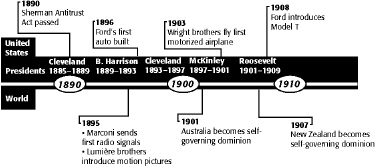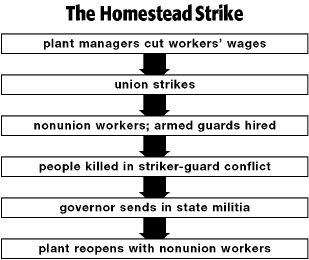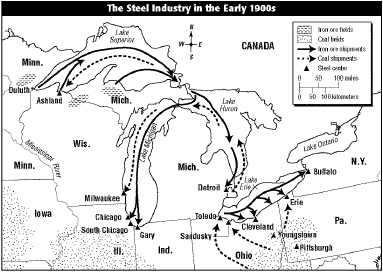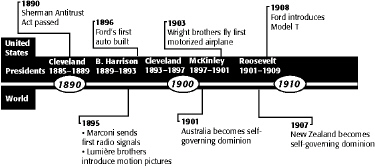Multiple Choice
Identify the
choice that best completes the statement or answers the question.
|
|
|
1.
|
The practice of combining separate companies in an industry is called a
a. | rebate. | c. | consolidation. | b. | monopoly. | d. | philanthropy. |
|
|
|
2.
|
The inventor of the railroad sleeping car was
a. | Eli H. Janney. | c. | Henry Ford. | b. | Gustavus Swift. | d. | George M.
Pullman. |
|
|
|
3.
|
Who linked the United States and Europe with a transatlantic telegraph
line?
a. | George Eastman | c. | Edwin L. Drake | b. | Cyrus Field | d. | Thomas Edison |
|
|
|
4.
|
Which inventor's most important invention was the electric
lightbulb?
a. | Thomas Edison | c. | Henry Ford | b. | Granville Woods | d. | George Eastman |
|
|
|
5.
|
Whose shoe-making machine performed many steps previously done by hand?
a. | Lewis H. Latimer | c. | Jan E. Matzeliger | b. | John Thurman | d. | Christopher
Sholes |
|
|
|
6.
|
Which the steel company owner was a great philanthropist?
a. | Granville Woods | c. | Andrew Carnegie | b. | Gustavus Swift | d. | Cyrus Field |
|
|
|
7.
|
The combining of companies is called
a. | dividends. | c. | corporations. | b. | shareholders. | d. | mergers. |
|
|
|
8.
|
Who invented the telephone?
a. | George Westinghouse | c. | Cyrus Field | b. | Thomas Edison | d. | Alexander Graham
Bell |
|
|
|
9.
|
Who pioneered the assembly line?
a. | Henry Ford | c. | Thomas Edison | b. | Jan Matzeliger | d. | Cyrus Field |
|
|
|
10.
|
Child-labor laws were passed for children working in
a. | agriculture. | c. | factories. | b. | retail. | d. | mining. |
|
|
|
“I’ve been working on the railroad,
All the
live-long day,
I’ve been working on the
railroad,
Just to pass the time
away.” | |
|
|
|
11.
|
 While singing songs such as the one in this
excerpt, laborers built miles of track to expand the United States railway system. As this happened,
railroad companies became consolidated, which means a. | companies added new stations and hired many more employees. | b. | separate companies
became combined into larger companies. | c. | more locomotives and passenger trains were
scheduled between big cities. | d. | many more places were connected up to the
large, new passenger trains. |
|
|
|
“. . . This, then, is held to be the duty of the man
of wealth: first, to set an example of modest, unostentatious living, . . to provide moderately for
the legitimate wants of those dependent upon him; and after doing so to consider all surplus revenues
which come to him simply as trust funds which he is called upon to administer, . . . in the manner
which, in his judgment, is best calculated to produce the most beneficial results for the
community—the man of wealth thus becoming the mere agent and trustee for his poorer brethren,
bringing to their service his superior wisdom, experience, and ability to administer, . .
.”
–Andrew Carnegie, “Wealth,” The
North American Review, June 1889 | |
|
|
|
12.
|
 Which statement best describes, in
Carnegie’s opinion, the duty of the man of wealth? a. | After taking care of his needs, he should give all his money to his family and their
friends. | b. | He should share his fortune with his managers and employees . | c. | After taking care of
his and his family’s needs, he should spend his money to benefit the
community. | d. | He should save his money and pass it on to his
descendants. |
|
|
|
“At seven o’clock we all sit down to our
machines and the boss brings to each one the pile of work that he or she is to finish during the day.
. . . This pile is put down beside the machine and as soon as a skirt is done it is laid on the other
side of the machine. . . . The machines go like mad all day, because the faster you work, the more
money you get. Sometimes in my haste I get my finger caught and the needle goes right through it. . .
. We all have accidents like that. . . . Sometimes a finger has to come off. . . . All the time we
are working the boss walks about examining the finished garments and making us do them over again if
they are not just right. So we have to be careful as well as swift. . . .”
–Account of a young woman working in New York City’s garment
industry | |
|
|
|
13.
|
 According to this passage, working too fast
could cause _____. a. | machines to break down | c. | the boss to offer a day off | b. | coworkers to get
angry | d. | accidents and
mistakes to occur |
|
|
|
14.
|
  Based on the time line, how
many terms did Theodore Roosevelt serve as United States president? a. | one | c. | three | b. | two | d. | none of the
above |
|
|
|
|
|
|
15.
|
 | Which of the following innovations on the map was developed by Gustavus
Swift? | | |
a. | the transcontinental route | b. | lighter trains that took only 10 days coast to
coast | c. | the refrigerated railroad car | d. | air brakes |
|
|
|
16.
|
 Which railroad connected California and
Utah? a. | Union Pacific | c. | Central Pacific | b. | Northern Pacific | d. | Atchison, Topeka and Santa
Fe |
|
|
|
17.
|
 Based on the map, which railroad lines would a
traveler have to take to get from Kansas City, Missouri to Promontory Summit, Utah? a. | Atlantic and Pacific R.R. & Southern Pacific R.R. | b. | Northern Pacific
R.R. & Southern Pacific R.R. | c. | Central Pacific R.R. & Union Pacific
R.R. | d. | Kansas Pacific R.R. & Union Pacific R.R. |
|
|
|
18.
|
 Based on the information on the map, what 1870s
innovation allowed meat and produce to be more efficiently transported by rail? a. | passenger cars | c. | cow catchers | b. | refrigerated cars | d. | diesel engines |
|
|
|
|
|
|
19.
|
 Based on the map, what time is it in Texas when
it is 4:00 P.M. in Alaska? a. | 3:00 P.M. | c. | 6:00 P.M. | b. | 5:00 P.M. | d. | 7:00 P.M. |
|
|
|
20.
|
 How many time zones are there in the 48
continental United States?
|
|
|
|
|
|
21.
|
 Based on the information on the map, in which
years did landmark labor struggles take place in the State of Illinois? a. | 1877 & 1886 | c. | 1886 & 1894 | b. | 1886 & 1892 | d. | 1892 & 1902 |
|
|
|
22.
|
 According to the map, where did the Great
Railway Strike begin? a. | Scranton, PA | c. | Homestead, PA | b. | Martinsburg, WV | d. | Ludlow, CO |
|
|
|
23.
|
 How did the Silver Mines Unrest end? a. | Federal troops quelled riots. | b. | The Colorado militia burned the miners’
tent colony. | c. | The miners won union recognition. | d. | Idaho jailed hundreds of striking
workers. |
|
|
|
24.
|
  Based on the flowchart, which
of the following did not lead to the governor sending the state militia in to deal with the
Homestead Strike? a. | plant reopens with nonunion workers | b. | plant managers cut workers’
wages | c. | nonunion workers; armed guards hired | d. | union strikes |
|
|
|
25.
|
  Based on the map, which of
the following statements is correct? a. | Indiana was rich in iron ore fields. | b. | Illinois was rich in iron ore
fields. | c. | Iron ore fields were north of coal fields. | d. | Iron ore fields were
south of coal fields. |
|
|
|
|
|
|
26.
|
 If the average work day was 12 hours per day,
and the work week was 6 days, how much would a machine woodworker earn in a week? a. | $30.00 | c. | $9.00 | b. | $15.00 | d. | $18.00 |
|
|
|
27.
|
Originally, railroad tracks were made of
a. | iron. | c. | copper. | b. | steel. | d. | zinc. |
|
|
|
28.
|
By the late 1880s, almost all railroad companies had adopted
a. | iron tracks. | c. | air brakes. | b. | five time zones. | d. | a standard
gauge. |
|
|
|
29.
|
Who invented the typewriter?
a. | Alexander Graham Bell | c. | William Burroughs | b. | Thomas Edison | d. | Christopher
Sholes |
|
|
|
30.
|
Thomas Edison's most important invention was the
a. | electric lightbulb. | c. | camera. | b. | vacuum cleaner. | d. | automatic circuit
breaker. |
|
|
|
31.
|
Gaining almost total control of an industry is called
a. | a monopoly. | c. | horizontal integration. | b. | vertical
integration. | d. | a
dividend. |
|
|
|
32.
|
A tragic fire that broke out in the Triangle Shirtwaist Company factory led the
International Ladies' Garment Workers Union to push for
a. | shorter working hours. | c. | a safer working environment. | b. | hazard
pay. | d. | higher
wages. |
|
Completion
Complete each
statement.
|
|
|
33.
|
Construction of ____________________ increased the demand for iron, steel, coal,
timber, and other goods.
|
|
|
34.
|
The industrial growth of the late 1800s created thousands of new
____________________ for American workers.
|
|
|
35.
|
In 1866 a transatlantic ____________________ cable connected the United States
with Europe.
|
|
|
36.
|
The telephone and the ____________________ greatly improved communication over a
distance and further unified the nation.
|
Short Answer
|
|
|
|
|
|
37.
|
 | How much longer did it take to produce a Model T in 1908 than in
1913? | | |
|
|
|
38.
|
 | In what year were the Model Ts the least expensive? Why? | | |
|
|
|
39.
|
 | How much more did it cost to buy a Model T in 1908 than in 1916? | | |
|
|
|
40.
|
 | In what year were the Model Ts the most expensive? Why? | | |
|
|
|
“ . . . What was worked
out at Ford was the practice of moving the work from one worker to another until it became a complete
unit, then arranging the flow of these units at the right time and the right place to a moving final
assembly line from which came a finished product. Regardless of earlier uses of some of these
principles, the direct line of succession of [this process] and its intensification into
automation stems directly from what we worked out at Ford Motor Company between 1908
and 1913. . . .”
–Charles E. Sorenson, My Forty Years with Ford
|
|
|
41.
|
 | What new business technique referred to in this passage lowered manufacturing
costs and also prices of products? | | |
|
|
|
“ . . . In practice, [this] consists of the
farming out by competing manufacturers to competing contractors the material for garments, which, in
turn, is distributed among competing men and women to be made up. The middleman, or contractor, is
the [oppressor] (though he also may be himself subjected to pressure from above) and his
employees are the . . . oppressed. He contracts to make up certain garments, at a given price per
piece, and then hires other people to do the work at a less price. His profit lies in the difference
between the two prices. In the process he will furnish shop room and machines to some, and allow
others, usually the finishers, to take the work to their living and lodging rooms in tenements. . .
.”
–Illinois Bureau of Labor Statistics report,
1893 | |
|
|
|
42.
|
 | What is the system described in this passage called? | | |
|
|
|
43.
|

 | Based on the time
line, under whose presidential administration was the Model T automobile introduced? | | |
|
|
|
44.
|
What three industries grew as a result of demand for their products by the
railroads?
|
|
|
45.
|
Who was known as the “Wizard of Menlo Park”?
|
|
|
46.
|
What were some inventions that came from the Menlo Park laboratory?
|
|
|
47.
|
Who created a monopoly in the oil industry?
|
|
|
48.
|
Who was the leading figure in the early years of the American steel
industry?
|
|
|
49.
|
What is philanthropy?
|
|
|
50.
|
Why did nearly 150 workers, mostly young immigrant women, perish in the fire at
the Triangle Shirtwaist Company in 1911?
|